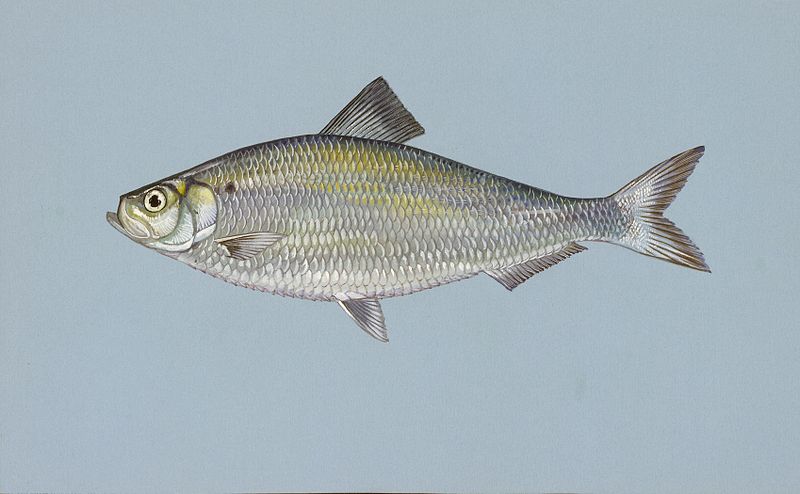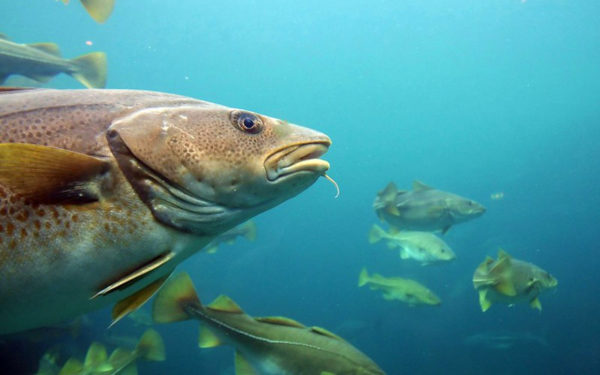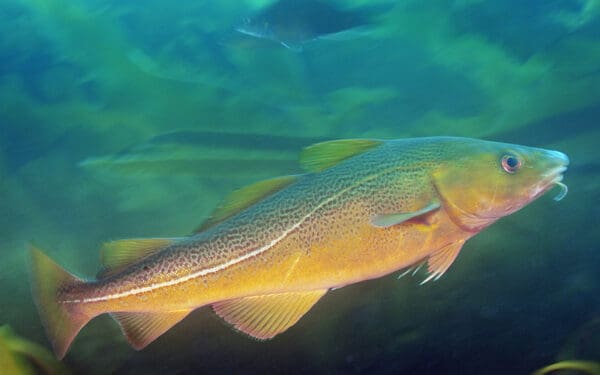
Alewife populations plunged to historic lows in the early 2000s, but efforts to restore access to their native spawning grounds are paying off. Photo: By Duane Raver, U.S. Fish and Wildlife Service, via Wikimedia Commons
It’s that time of year when fish like alewives and blueback herring journey from the sea to their native fresh waters to spawn. As a keystone species, these fish, collectively known as river herring, play a critical role as building blocks in our coastal ecosystems. They are also important to the health of New England’s fisheries, serving as food for cod, salmon, and striped bass, as well as bait fish for lobstermen.
Fossil remains discovered at some of Maine’s coastal rivers show that river herring’s annual pilgrimage – from the river as juveniles, out to the ocean, and then back to the river to spawn – has been going on for hundreds (if not thousands) of years. That is, until access to many of these rivers were dammed stem to stern and river herring were blocked from returning to their native habitat.
As a result, river herring were all but wiped out from our coastal rivers. On Maine’s St. Croix River, for example, a once-booming population of 2.5 million alewives in the 1980s plummeted to barely 900 in 2002. But today, river herring are making a comeback – the result of years of work by CLF and our partners to restore the species to health.
So far this year, more than 116,000 fish have made the run up and over the St. Croix’s Milltown dam fishway to their native spawning waters – the most fish to do so since 1996. But there’s more work to do to ensure the success of this recovery effort.
An Uphill Battle to Return Herring to Maine’s Rivers
Restoring access to native habitat for these species is a time-consuming and uphill battle. And even after access has been restored, it takes herring several generations to complete the journey from spawning waters to the open ocean and back again before a significant population increase can be seen.
Before this biological struggle can even begin, however, a maze of permits, licenses, and approvals must be navigated. On the federal level, the Federal Energy Regulatory Commission, the U.S. Fish and Wildlife Service, Environmental Protection Agency, National Marine Fisheries Service, and the Army Corps of Engineers all play a role.
As do state agencies. Here in Maine that includes the Maine Department of Environmental Protection, Department of Marine Resources, and Department of Inland Fisheries and Wildlife.
Beyond this alphabet soup of agencies, the owners of the dams – paper companies; large and small utilities; cities, towns, and individuals – all play a role. So do recreational and commercial fishermen, Maine’s tribes, property owners who’ve grown used to the impoundments created behind the dams, and whitewater enthusiasts. And, of course, groups like CLF are involved.
That’s a lot of cats to herd. But the results are well worth the effort, as we are seeing this year on the St. Croix and Presumpscot rivers, where CLF has been working for more than a decade to restore access to spawning grounds.
Long and Complex Struggles Showing Results
The St. Croix serves as the border with Canada as it travels down from Grand Lake to Passamaquoddy Bay. When its river herring population dipped dangerously low in the early 2000s, CLF began a fight to reopen fish ladders on the river that had previously been closed as a result of a 1995 state law. In 2013, we succeeded and now, four years later, river herring are returning to their native spawning grounds by the thousands – the 116,000 reported this year is only expected to grow in the years to come.
The Presumpscot River in southern Maine was once home to thousands of migratory fish before it was dammed. While alewives and river herring are already returning to the river in encouraging numbers, their passage will soon be made easier thanks to an agreement negotiated by CLF and our partners last November that will ultimately remove three dams from the river.
On June 1, an appeal of this historic agreement that aimed at slowing down the removal of the dams was denied by the Maine Board of Environmental Protection. This clears the way for the development of plans for Sacarappa Falls, the first dam to be removed. CLF, our partner Friends of the Presumpscot River, and state and federal agencies will design the most effective means for fish to pass through the area. Once the design is approved by federal and state agencies, we expect fish passage will begin by 2019.
Results like these take patience, persistence, and partnerships. CLF is committed to using the lessons learned on the Presumpscot and St. Croix Rivers to restore habitats for these keystone species in Maine and throughout New England – which will benefit not just river herring populations, but our fishing economy and the health of the entire coastal ecosystem – which benefits all of us in the long run.



